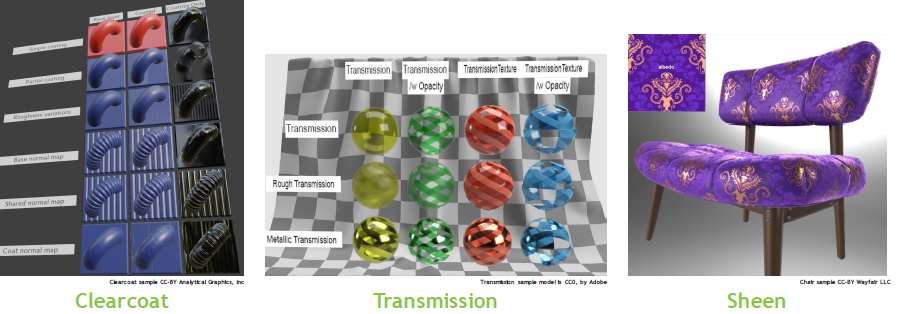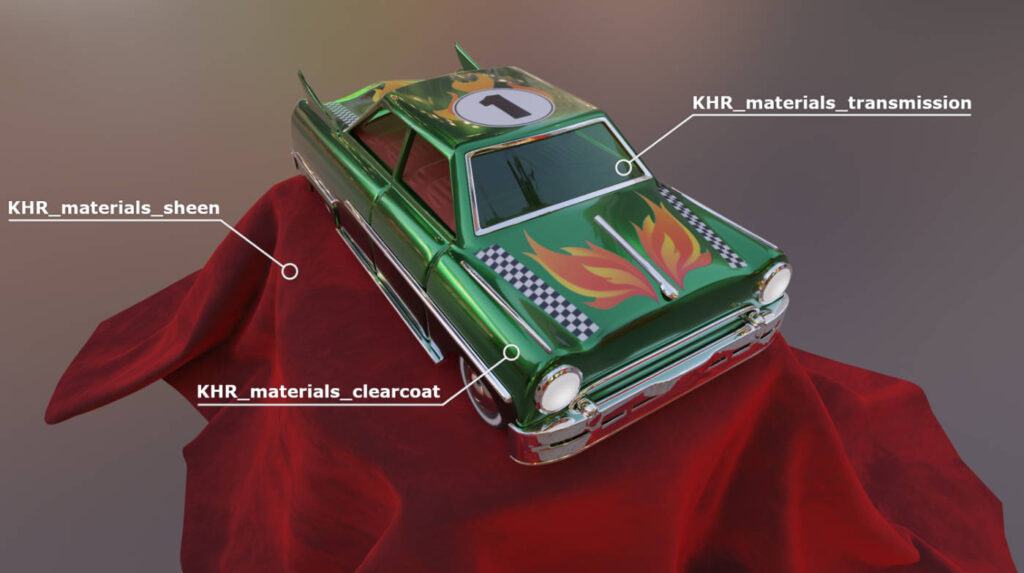The Khronos Group has released a set of new Physically Based Rendering (PBR) material extensions for glTF, a royalty-free format for the efficient transmission and loading of 3D scenes and models by engines and application. The new extensions for Clear Coat, Transmission, and Sheen are built on the existing PBR capabilities of glTF 2.0. The extensions are a step toward creating an interoperable, physically-based material model for the glTF ecosystem.

- The KHR_materials_clearcoat extension defines a clear coating that can be layered on top of an existing glTF material definition. A clear coat is a common technique used in Physically-Based Rendering to represent a protective layer applied to a base material.
- The KHR_materials_transmission extension enables the creation of transparent materials that absorb, reflect, and transmit light depending on the incident angle and the wavelength of light.
- The KHR_materials_sheen extension defines a sheen that can be layered on top of an existing glTF material definition. A sheen layer is a common technique used in Physically-Based Rendering to represent cloth and fabric materials.
These next-gen PBR material extensions are going to produce very realistic and interoperable 3D content. There is vast industry support available for them as users are looking forward to adopting the extensions for handling the complex real-world objects. During the COVID-19 times, when our presence has become more virtual than physical in the world, there is a growing need for advanced open standards to support widespread 3D content creation. Lifelike realistic 3D renderings are going to enhance our virtual experience in online shopping, gaming, education, etc.
The press release follows:
Beaverton, OR – December 3, 2020 – Today, The Khronos Group, an open consortium of industry-leading companies creating advanced interoperability standards, announces the release of a set of new Physically Based Rendering (PBR) material extensions for glTF. glTF is Khronos’ royalty-free format for widespread, efficient transmission and loading of 3D scenes and models, known in the industry as the ‘JPEG of 3D’. PBR enables developers and artists to achieve photorealism through rendering parameters that correspond to real-world physical properties of materials in 3D assets. These new extensions for Clear Coat, Transmission and Sheen build on the existing PBR capabilities of glTF 2.0, and together with additional upcoming extensions, are creating a powerful, interoperable, physically-based material model for the glTF ecosystem.

Model created by Guido Odendahl, visualized by the Stellar Path Tracer from Dassault Systèmes, distributed under CC0 license.
Existing core glTF 2.0 PBR materials define parameters for Base Color, Metalness, Roughness, Emission, Normal Map, and Baked Ambient Occlusion. This creates a powerful, yet simple to implement PBR model for high-quality, visually realistic 3D assets that are portable to any rendering API and viewer, while being scalable to suit the capabilities of diverse platforms including mobile devices. By defining rendering parameters based on physical properties, instead of using model-supplied shader code, viewing engines and applications are able to implement and optimize their own rendering shaders while preserving visual consistency.
The Khronos 3D Formats Working Group is now expanding glTF’s core PBR capabilities by releasing material parameters in glTF extensions for Clear Coat, Transmission, and Sheen.
- The KHR_materials_clearcoat extension adds a layer of shine and polish. It is a critical graphical element for the automotive industry, for example, to showcase realistic paint finishes without breaking the laws of energy conservation which can create an unnatural shine.
- The KHR_materials_transmission extension models light passing through a material, preserving specular reflections that would be visible on a shiny transmissive surface to provide a physically-correct approximation of materials such as glass, stained glass, water, and clear or partially colored plastic. This extension uses ‘Roughness’ from the base glTF PBR model to blur the transmission. In this first version, thin-walled transmission is directly supported, and the extension has been designed to be compatible with future material properties that may provide a thick volumetric material definition.
- The KHR_materials_sheen extension provides sheen roughness and sheen color channels to simulate the effect light has when it hits microfibers in cloth. This is key for artists working on apparel, furniture, or other items made of cloth or fuzzy materials.
“The Khronos 3D Formats Working Group is fortunate to host many industry-leading experts that are working to build industry consensus on interoperable PBR—and using glTF as a vehicle to make it deployable across diverse platforms and devices,” said Neil Trevett, Khronos president. “Also, the unique mix of technology and e-commerce companies at Khronos’ 3D Commerce Working Group is generating real-world insights that are informing and motivating the evolution of the glTF PBR roadmap.”
Leading rendering engines such as Microsoft’s Babylon.js, Google’s Filament, and three.js already support some or all of the new PBR extensions, together with applications including Adobe’s Dimension (prerelease channel), Blender, UX3D’s Gestaltor, and AGI’s Systems Tool Kit (STK). Sample assets illustrating these new PBR capabilities are available in the official glTF sample model repository.
Upcoming glTF PBR extensions will include sophisticated material properties such as subsurface scattering, light attenuation, index of refraction, and anisotropy that interact seamlessly with glTF’s PBR model. Khronos is seeking feedback and requirements from implementers, engine developers, content creators, and artists to influence glTF’s PBR model roadmap—see “Ways to contribute to glTF” on GitHub, or reach out to us on Twitter. Any company that wishes to participate directly in the 3D Formats Working Group to help evolve the glTF specification and ecosystem is invited to join the Khronos Group for access to all its standardization activities.
Industry support for glTF 2.0 and next generation PBR
“These new PBR extensions are the beginnings of a broadly interoperable, sophisticated physically-based material model for the glTF ecosystem. From these extensions and the ones that will follow, we expect to see improved visual fidelity across a range of industries from retail to games to scientific visualization – and digital mission engineering with AGI’s Systems Tool Kit (STK),” said Ed Mackey, Khronos PBR TSG chair, and advisory software developer, Analytical Graphics, Inc.
“You can’t discuss modern 3D publishing formats without mentioning glTF, and Autodesk is proud to be part of the glTF file format adopter program as we push toward integration in our content creation tools. Initiatives such as PBR Next are closely aligned with our own vision of next generation material models, following the stringent demands of our customers seeking the very best in photorealism. We are thrilled to play a part in the development of glTF, sharing our knowledge and learning from others, as well as accelerating the adoption of new extensions,” said Brent Scannell, product manager at Autodesk.
“Realistic representation of products and the environment is a critical contribution for the experience economy. The new PBR extensions add precision and emotion to virtual representations of the real world, driving deeper engagement with people everywhere,” said Tom Acland, CEO at Dassault Systèmes, 3DEXCITE.
“The next generation PBR extensions for glTF will allow us to optimize and deploy many more 3D models of our clients as photorealistic real-time assets, even when they include complex or tricky real-world materials, like coated surfaces or velvet,” said Dr. Max Limper, CEO at DGG and Khronos 3D Commerce Asset Creation TSG co-chair.
“The realism of the 3D rendering is a key part of the user experience, even more so when it comes to interactive product visualization and augmented reality for eCommerce. The latest glTF PBR extensions are a major step forward as they make it possible to support more complex materials and so extend the scope of products that can be shown with realistic 3D rendering in a standardized way across different platforms,” said Aurélien Vaysset, co-founder and CEO of Emersya.
“We have to manage a lot of 3D data from different applications. We need to export polygons, share UV mappings and textures between different software, but the real challenge is in how the surface reacts to light and its standardization. I remember a lot of GDC shader standardization round tables, and finally today Khronos is delivering glTF PBR extensions for greater accuracy and realism,” said Fabrizio Dini, COO at Invrsion.
“Glass, liquids, fabrics and coated surfaces make up a big part of the world surrounding us. We are excited that glTF can now represent such materials with high fidelity, enabling the deployment of more realistic 3D assets and believable virtual worlds. These new extensions are fully compatible with the NVIDIA Material Definition Language (MDL), enabling the seamless display of all glTF materials by MDL enabled renderers. We look forward to rendering all the great content artists will exchange using glTF!,” said Jan Jordan, senior software product manager MDL, NVIDIA.
“The new extensions enhance the glTF material system to improve the realism of 3D content and products. These important new material features again empower glTF to be the JPEG for 3D. We are supporting these new glTF extensions from day one in our visual glTF editor Gestaltor,” said Norbert Nopper, managing director at UX3D.
“The latest glTF PBR extensions, such as Sheen, Transmission and Clearcoat, are narrowing the gap between virtual and real products, giving developers and artists the tools to create incredibly lifelike 3D models. Wayfair is excited to be part of this ongoing effort to push the state of the art forward by building open and interoperable standards. This latest set of glTF extensions will raise the bar for virtual product quality online and in turn benefit the entire retail industry. We are proud to be actively contributing toward this effort by driving the requirements and development of the extensions and standards, while serving our customers the most realistic and accurate representation of products to virtually view in their space,” said Shrenik Sadalgi, chair of the 3D Commerce Working Group & director of R&D at Wayfair.





